& Specifications (in progress)
K&N Air FiltersAftermarket Air Filters have In the vast majority of cases, increased airflow will increase engine performance measured by horsepower and throttle response (torque). K&N is one of the largest aftermarket suppliers for motorcycle air filters.
- Facts You Should Know About Air Filters
- What’s the Big Deal About Air Flow?
- A Word About Filtration Requirements
- Filtration 101 – A Deeper Cut
- Paper vs K&N
- Stock Replacement Filters
- Beyond the Stock Air Filter and Air Box
- Off-Road and Racing Off-Road
- Racing
- Filter Selection
Facts You Should Know About Air Filters
We believe the primary function of an air filter is to deliver both high airflow and superior dirt protection. We design K&N air filters to provide minimum restriction allowing high airflow into an engine. In the vast majority of cases increased airflow will increase engine performance measured by horsepower and throttle response (torque). The performance benefits of maximum airflow are clear, compelling and well documented. That is why so many professional racers are willing to run expensive vehicles with no air filter, as opposed to installing a disposable air filter. They are seeking the additional horsepower and throttle response needed to win the race.
We design K&N air filters to provide superior filtration of the contaminants that can harm your engine while maximizing the airflow characteristics of the filter in question. The ability of an air filter to protect your engine is generally measured using a testing procedure developed by the Society of Automotive Engineers identified as the SAE J726 procedure. K&N subject a sample of K&N filter designs to this test procedure using Coarse Test Dust, which includes particles ranging in size from less than 5.5 microns to 176 microns. As a point of reference, a human hair is approximately 50 microns in diameter. The result of the above test procedure is a specific air filtration efficiency number. This efficiency number represents the percentage of test dust retained by the filter and thereby kept out of an engine. K&N goal is to design K&N air filters to achieve maximum airflow while targeting overall filtration efficiency at 98%.
Because no two air filters are alike, the specific airflow and overall filtration efficiency will vary depending on the filter in question. However, you can rest assured that each air filter K&N sell, has been designed to achieve high air flow while providing superior filtration.
Both air flow and dirt protection are critical to engine performance. For this reason a consumer should always evaluate an air filter based on both its filtration efficiency and air flow capabilities. It is very easy to design an air filter that exhibits high airflow simply by reducing its filtration to unacceptable levels. As the “look” of a K&N air filter has become popular, many companies have begun offering products that copy that “look.” While imitation is said to be the sincerest form of flattery, K&N own testing has shown that many of these look-alike products do not provide a safe level of engine protection.
What’s the Big Deal About Air Flow?
Simply put, Everything! At its most basic level, an engine is an air pump. More air entering the engine increases the efficiency of the combustion process creating more horsepower and torque. Horsepower is a measure of the engine’s maximum power while torque measures how quickly you can accelerate.
The K&N Filtercharger® is designed to increase engine performance in both horsepower and throttle response by reducing air flow restriction.
Maintaining optimal, unrestricted air flow becomes a problem when it must pass through a filtering medium. The level of air resistance varies depending on the size, surface area and physical attributes of the filtering medium.
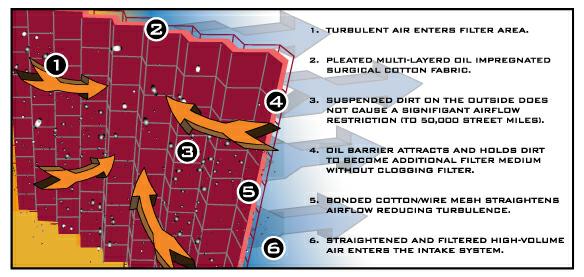
A Word About Filtration Requirements
There are few areas more confusing than identifying dirt retention requirements when it comes to air filters. Most vehicle owner’s manuals remain silent on the point. In fact, few air filter manufacturers publish any information as to the filtration efficiency of their filters. This stands in marked contrast to oil and fuel filters where there is a relatively large amount of information regarding filtration requirements and capabilities. Studies have shown most engine wear is caused by particles 10 to 20 microns in size. K&N air filters, like most quality disposable air filters, provide excellent filtration of these particles.
To ensure K&N air filters provide a high level of dirt protection, K&N regularly test K&N air filter designs using the testing procedure described above. Those tests demonstrate K&N air filters generally achieve overall filtration efficiency in the range of 97% – 98%, while some of K&N air filter designs have achieved levels as high as 99%. The fact that K&N air filters at times reach overall filtration efficiencies as high as 99% while maintaining high airflow is a testament to the quality and capabilities of K&N oil impregnated cotton air filter medium.
On occasion K&N see “new” air filter media’s developed and sold under the premise they provide increased levels of dirt filtration. More often than not, as opposed to quoting specific efficiency numbers, this “increased protection” is described as increased dirt retention capacity, meaning the filter can hold more dirt before requiring replacement. Remember, K&N air filters have always provided a service life in excess of disposable filters and then only require cleaning and oiling for re-use.
We encourage customers to do their homework and be aware of the filtration capabilities of an air filter before they buy. K&N own testing has revealed wide differences in filtering capabilities. K&N were surprised to see some disposable paper air filters with an overall filtration efficiency as low as 93%. K&N hope we have provided enough information to ensure consumers know what they are getting when they buy a K&N air filter.
Most people believe that all air filters function on a go/no go basis where dirt particles that are larger than the openings in the filter media are trapped while particles that are smaller than the openings can pass right through. A dry paper air filter does function in this manner. That’s why paper filters are so restrictive to air flow. The openings in this type of filter have to be very small to filter efficiently.
The oiled cotton media used in the K&N air filter functions in an entirely different manner. There are scientific principles that determine how an air filter removes dirt particles from the air stream. The first of these principles is known as interception, which applies to dirt particles traveling with the air stream. Air flow will always take the shortest path and as the air is forced to flow around the filter’s fibers some of the particles will contact the sides of the fibers and be captured. These particles are then held in place by the oil or tacking agent in the fiber.
Another principle is known as impaction, which mostly affects larger or heavier dirt particles. Impaction occurs when the inertia or momentum of the particle causes it to deviate from the flow path. In other words the heavy particles do not follow the air stream around the filter’s fibers but instead they run straight into the fibers and are captured.
The most important principle for K&N use is diffusion, which deals with the laws of physics that govern the motion of very small dirt particles. Small particles are highly affected by the forces in the air stream. Forces such as velocity changes, pressure changes, turbulence caused by other particles and interaction with the air molecules cause these very small particles to become random and chaotic. As a result, these particles do not follow the air stream and their erratic motion causes them to collide with the filter’s fibers. This phenomenon enables an air filter to capture dirt particles that are much smaller than the openings in the media. In addition, the way that dirt collects or loads on the K&N filter is very different. A paper filter exhibits “surface loading” which means dust collects only on the surface of the media. In contrast, K&N filters exhibit “depth loading”. The multiple layers of cotton fibers provide many levels of dust retention. This characteristic allows the K&N filter to hold significantly more dirt per square inch of media than the average paper filter. Utilizing these scientific principles, K&N has been able to design an air filter that is very free flowing while also being highly efficient at removing dirt from the air.
To meet minimum filtration standards, paper air filters must be thick and/or the fibers must be tightly compressed and dense. Therefore paper elements that provide adequate filtration are more restrictive to air flow by design. Additionally, as a paper filter becomes more and more clogged, the pressure inside the filter drops while the atmospheric air pressure (approximately 14.7 psia at sea level) outside the filter remains the same. It’s like using your lungs to draw the air out of a plastic milk bottle. When the pressure differential becomes too great, the bottle will collapse. The same thing could happen to your paper filter, although it is unlikely. But what will happen could be just as severe. An excessively high pressure differential created by a restricted filter can literally pull dirt particles through the paper medium. In other words, the performance of a paper filter, i.e. air flow through the filter and its ability to protect your engine, DECREASES near the end of its service interval.
| Disposable Paper Air Filter | |
|---|---|
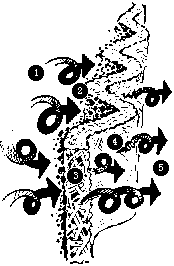 |
|
| Typical Foam Air Filter | |
|---|---|
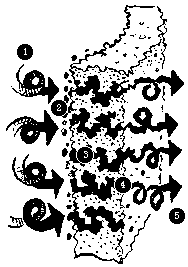 |
|
The K&N air filter is somewhat more complex. The unique design features multiple layers of oiled cotton fabric which captures the airborne dirt particles. These dirt particles cling to the fibers of the filter and actually become part of the filtering media. This process, known as depth loading, allows the K&N air filter to retain significantly more dirt per square inch than a paper filter. The cotton fabric is sandwiched between pleated aluminum screen. Pleating increases surface area which in turn prolongs service intervals. Pleating exposes substantially more surface area compared to a flat element like foam.
The dirt particles collected on the surface of a K&N element have little effect on air flow during much of its service life because there are no small holes to clog. Particles are stopped by layers of crisscrossed cotton fibers and held in suspension by the oil. As the filter begins to collect debris, an additional form of filter action begins to take place because air must first pass through the dirt particles trapped on the surface. That means a K&N air filter continues to exhibit high air flow throughout the life of the filter while it is accumulating dirt. At the same time, the air flow for an average paper air filter can decrease dramatically as the paper element gets dirty. So as dirt accumulates, the performance advantages of a K&N air filter can increase! Tests performed by an independent laboratory commonly known as the Frazier Permeability Test have shown that the Medium used in K&N air filters flows more than 300% more air than paper air filter medium when compared on a square inch per square inch basis. A Square inch comparison is not directly proportional to the increase you can expect from installing a K&N air filter in replacement of a paper air filter due to the effect of such things as filter size, number and depth of pleats. However, you can be assured a K&N air filter will provide dramatically more air flow which can enhance engine performance.
K&N replacement air filters are designed to provide up to a 4% increase in horsepower and torque. The amount of performance gain varies from vehicle to vehicle based on the overall factory air intake design. The greater the restriction created by the stock paper element, the greater the potential performance gain when you switch to a K&N.
The airflow comparison charts below are for two individual stock replacement air filters sold by K&N. The tests were performed in a dust-free environment on laboratory equipment. Flow comparison results will vary depending on part number, vehicle application and barometric air pressure.
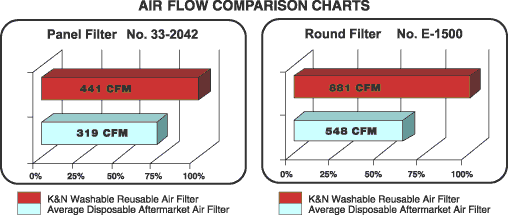
Beyond the Stock Air Filter and Air Box
Addressing the next area of restriction, K&N engineers looked at the vehicle’s air box (the container that houses the air filter) and any hoses or duct work connecting it to the engine. Because the air must first travel through this system before it reaches the carburetor or throttle body, the overall size and shape of the system has a profound effect on air flow. Air, like water, does not like to turn corners nor does it react favorably when confronted by an obstruction such as a sharp bend in a hose or a baffle. In many cases, the air box and/or the hoses and duct work used to create the air filtration system is just as restrictive as the original paper filter element. In some extreme cases, the air box and/or the air delivery system is the greatest source of restriction. The inlet to the air box is a good example. In many instances this opening is one half the cross sectional area of the throttle body or carburetor opening. It would be like trying to run a marathon while breathing through a soda straw.
An original-equipment cylindrical air cleaner box covering a throttle body or carburetor is another example. Most often, these round air cleaner housings are sealed to the outside air. The engine must then breathe through a snorkel attached to the perimeter of the housing. At times the snorkel is fed through a network of hoses and scoops.
To directly address the problem, K&N introduced a line of air intake kits, the most popular of which is K&N Fuel Injection Performance Kits (better know by the acronym, FIPK). These kits replace both the air box and the restriction. K&N FIPKs vary in design because they are application specific meaning each kit is engineered to fit a particular make, model and year of vehicle. FIPKSutilize a 360-degree filter design which provides increased surface area to promote air flow.
An air filter element becomes an insurance policy when used in off-road applications. Competitors will sacrifice a high-tech engine for a chance to win a race — but to win, they must finish. If the engine ingests too much dirt and debris, it may die an ugly death before the vehicle can cross the finish line.
You might think this would be the perfect application for an inexpensive, throw-away paper filter. But remember, in competition a little extra horsepower can mean the difference between coming in first or finishing second. The air filter now becomes an important part of the performance package.
K&N air filters are designed to provide minimum restriction long after disposable air filters have begun choking an engine. In other words, due to its characteristics, the restriction of a K&N replacement filter increases at a slower rate when compared to a disposable filter, i.e. a K&N filter will last longer under the same conditions. That’s why most off-road competitors choose K&N filters.
In a hypothetical 24-hour off-road race to further the point, a properly sized K&N filter will see the racer through to the end with cfm to spare. The equivalent disposable air filter, on the other hand, will need to be replaced with a fresh element to ensure the engine has an adequate supply of air to complete the course. A K&N will provide excellent filtration without sacrificing air flow for a longer period of time — that’s performance with value.
One might consider a paved road course or oval track as a clean air zone. After all, how much dirt and debris could be hovering above an asphalt track?
Subscribing to that theory, a road racer may elect to forgo an air filter in favor of large volumes of unrestricted air. However, testing the theory using an air filter enclosed in a vented housing should dispel the myth. The filter and housing will trap particles of loose trash kicked up by other race cars during the heat of battle. Dirt, small stones and pieces of shredded rubber expelled from soft compound racing tires can be found inside the housing after even a short race. Once a driver, car owner or engine builder realizes just how much trash is thrown around during a normal race, few would expose their expensive engines to unfiltered air in future events.
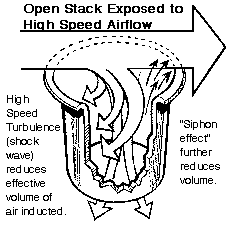 Whenever possible, performance enthusiasts should install a K&N 360 degree open-element filter. A correctly sized conical or round filter will deliver virtually unrestricted air flow. And, as K&N have learned, providing the engine with all of the air it needs promotes optimum performance. In a high speed application, a K&N filter will straighten the air which counteracts turbulence.
Whenever possible, performance enthusiasts should install a K&N 360 degree open-element filter. A correctly sized conical or round filter will deliver virtually unrestricted air flow. And, as K&N have learned, providing the engine with all of the air it needs promotes optimum performance. In a high speed application, a K&N filter will straighten the air which counteracts turbulence.
Straight cut velocity stacks, for example, pose a unique problem. Exposed to the outside air, velocity stacks experience a phenomena that actually hinders performance at high speed. K&N are referring to stacks and air horns that protrude through the hood and extend into the air stream so the direction of the air rushing over the car is at a perpendicular angle to the length of the tube.
Air moving rapidly over these stacks create turbulence inside the opening. At high speed, the rushing air tends to create a partial vacuum inside the tube. The condition is counterproductive to air flow. The phenomena also effects open carburetors. The higher the ground speed, the greater the problem. Vacuum created by the engine is trying to coax air into the cylinders and the high speed air flowing over the open end of the stack is causing resistance.
Reversion creates other problems. In an automotive application, reversion refers to reversed air flow, or in simpler terms, it’s when air in the intake runner reverses direction for a split second. The condition is caused when a burst of pressure escapes into the intake runner from the cylinder during valve overlap.
Reversion creates resonance shock waves inside the tubes which exit the open end of the tube at various rates depending on engine speed. It has also been proven that these shock waves interfere with each other when the stacks are in close proximity.
Installing a free-flowing air filter on top of each stack or over the carburetor air horn eliminates these conditions. How? The solution is simply explained. The filter creates a plenum over the opening. Air entering the filter is slowed, smoothed and straightened. The filter then becomes an endless source of calm, clean air. Shock waves dissipate within the confines of the plenum without interfering with the shock waves emitted from an adjacent stack.
If maximum horsepower is the objective, the size and shape of the air filter element is paramount.
Let’s first consider shape. When fitting a conventional round filter on top of the engine, such as a carburetor, central fuel injection or throttle body fuel injection, K&N have found a large diameter, short filter will flow more air than a small diameter, tall filter. For example, a 10-inch diameter filter 2-inches tall will flow more air than a 5-inch diameter filter that is 4-inches tall. Where space permits, the height of the filter should be between 1/5 and 1/4 of its diameter.
The shape of the filter is less important if the application calls for a remote mounted filter, which includes many late model fuel injected models. Typically these vehicles will use a flat panel filter or a conical or cylindrical shaped filter with a rubber mounting flange designed to be mounted on the end of the inlet hose.
That brings us to size.
Use the formula below to compute the minimum size filter required for your particular application. The usable portion of the filter is called the EFFECTIVE FILTERING AREA which is determined by multiplying the diameter of the filter times Pi (3.1416) times the height of the air filter in inches, then subtracting .75-inch. We subtract .75-inch to compensate for the rubber seals on each end of the element and the filter material near them since very little air flows through this area.
|
|
| A = effective filtering area CID = cubic inch displacement RPM = revolutions per minute at maximum power |
| Example: A 350 CID Chevy engine with a horsepower peak at 5,500 rpm. |
|
|
If you are sizing a panel filter, multiply the width of the filter area (not the rubber seal) times its length. If you are sizing a round filter, use the following formula to determine the height of the filter.
|
|
| A = effective filtering area H = height D = outside diameter of the filter 3.14 = pi 0.75 = the rubber end caps |
| Example: |
 |
Referencing the K&N catalog shows the proper filter for this application would be an E-1500 which is 3.5 inches tall. Keep in mind, this is the minimum size requirement. To extend the service interval and to provide an even greater volume of air to the engine, install the largest filter that will fit in the space allotted. If the space above the engine is restrictive, perhaps a remote filter arrangement could be used to gain space.
Off-road conditions require added filter area. A filter should be sized 1-1/2 to 2 times larger than normal for any conditions that could be considered severe. In this case, the E-1500 used in K&N example should be replaced by an E-1120 or an E-1150. For long distance off-road events, two double-size remote mounted filters would be best.
